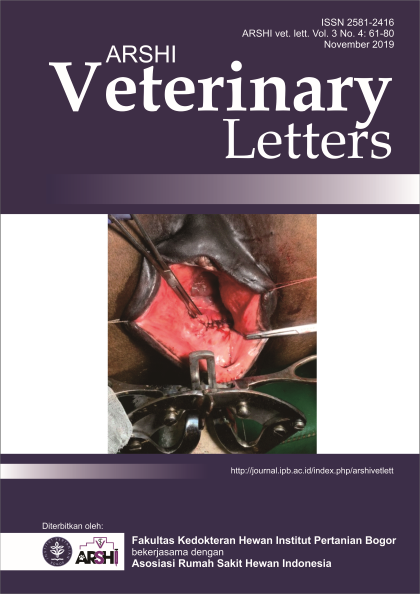Evaluation of ultraviolet-C lamps sterilization in veterinary operating theatre
Abstract
Ultraviolet (UV) lamp is the simplest method for sterilizing operating theatre. This method is effective, easily operated, and does not require high cost. Furthermore, there were several studies of microorganism contamination in the air and surface at human operating theatre. However, studies in veterinary operating theatre related to the effectiveness of UV light on sterilization process is still limited, especially in Indonesia. Bacterial contamination samples were collected three times each in three different conditions: A) before surgery and without UV, B) before surgery but UV was already used, and C) after surgery and UV was already used. Samples were taken with settle plate and swab method for collecting the air and operating table contamination, respectively. One-way repeated measures ANOVA determined that there was statistically significant difference in the number of bacterial contaminations between three conditions (A, B, and C) in settle plate method (p=0.009), as well as in swab method (p=0.010). The result revealed that the UV light was effective to sterilize operating theatre, which can be seen from the significant decreases on the number of bacterial contaminations before and after the UV was used, both in settle plate and swab method. The result of this study supported the theory that the UV light can reduce the air bacterial and surface contamination at operating theatre. However, the result of microorganism contaminations in this study was still not appropriate based on the standard minimum of total bacterial in the operating theatre from The Ministry of Health, Republic of Indonesia. Consequently, the use of another method of sterilization at the operating theatre is still required for a better sterilization result.Downloads
References
Hameed AAA, Habeeballah T. 2013. Air microbial contamination at the holy mosque, Makkah, Saudi Arabia. Current World Environment. 8(2):179-187.
Center for Disease Control and Prevention (CDC). 2008. Environmental control for tuberculosis: basic upper room ultraviolet germicidal irradiation guidelines for healthcare settings. Department of Health and Human Services. pp 6-7.
Kramer A, Schwebke I, Kampf G. 2006. How long do nosocomial pathogens persist on inanimate surfaces? A systematic review. BMC infectious diseases. 6(1):130.
Shakir IA, Patel NH, Chamberland RR, Kaar SG. 2015. Investigation of cell phones as a potential source of bacterial contamination in the operating room. JBJS. 97(3): 225-231
Copyright (c) 2019 CC-BY-SA

This work is licensed under a Creative Commons Attribution-ShareAlike 4.0 International License.
Authors who publish with this journal agree to the following terms:
1. Authors retain copyright and grant the journal right of first publication with the work simultaneously licensed under a Creative Commons Attribution License that allows others to share the work with an acknowledgement of the work's authorship and initial publication in this journal.
2. Authors are able to enter into separate, additional contractual arrangements for the non-exclusive distribution of the journal's published version of the work (e.g., post it to an institutional repository or publish it in a book), with an acknowledgement of its initial publication in this journal.
3. Authors are permitted and encouraged to post their work online (e.g., in institutional repositories or on their website) prior to and during the submission process, as it can lead to productive exchanges, as well as earlier and greater citation of published work (See The Effect of Open Access).
















